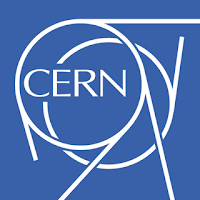CERN – European Organization for Nuclear Research logo.
13 Apr 2018
Proton slamming has resumed at the Large Hadron Collider (LHC). Almost a fortnight after the collider began circulating proton beams for the first time in 2018, the machine’s operations team has today steered beams into collision. While these are only test collisions, they are an essential step along the way to serious data taking, which is expected to kick off in early May.
Image above: A test collision recorded by the CMS experiment on 12 April 2018. The CMS collaboration uses these first collisions to prepare for data taking, fine-tuning and powering on various subsystems as needed. (Image: CERN).
Achieving first test collisions is anything but an easy job. It involves round-the-clock checking and rechecking of the thousands of systems that comprise the LHC. It includes ramping up the energy of each beam to the operating value of 6.5 TeV, checking the beams’ instrumentation and optics, testing electronic feedback systems, aligning jaw-like devices called collimators that close around the beams to absorb stray particles and, finally, focusing the beams to make them collide.
Each beam consists of packets of protons called bunches. For these test collisions, each beam contains only two “nominal” bunches, each made up of 120 billion protons. This is far fewer than the 1200 bunches per beam that will mark the start of serious data taking and particle hunting. As the year progresses, the operations team will continue to increase the number of bunches in each beam, up to the maximum of 2556.
With today’s test collisions, the teams of the experiments located at four collision points around the LHC ring (ALICE, LHCb, CMS and ATLAS) will now be able to check and calibrate their detectors. Stay tuned for the next steps.
Note:
CERN, the European Organization for Nuclear Research, is one of the world’s largest and most respected centres for scientific research. Its business is fundamental physics, finding out what the Universe is made of and how it works. At CERN, the world’s largest and most complex scientific instruments are used to study the basic constituents of matter — the fundamental particles. By studying what happens when these particles collide, physicists learn about the laws of Nature.
The instruments used at CERN are particle accelerators and detectors. Accelerators boost beams of particles to high energies before they are made to collide with each other or with stationary targets. Detectors observe and record the results of these collisions.
Founded in 1954, the CERN Laboratory sits astride the Franco–Swiss border near Geneva. It was one of Europe’s first joint ventures and now has 22 Member States.
Related article:
Beams are back in the LHC
http://orbiterchspacenews.blogspot.ch/2018/04/beams-are-back-in-lhc.html
Related links:
Large Hadron Collider (LHC): https://home.cern/topics/large-hadron-collider
ALICE: https://home.cern/node/119
LHCb: https://home.cern/node/122
CMS: https://home.cern/node/121
ATLAS: https://home.cern/node/120
For more information about European Organization for Nuclear Research (CERN), Visit: https://home.cern/
Image (mentioned), Animation (mentioned), Text, Credits: CERN/Ana Lopes.
Best regards, Orbiter.chArchive link






Комментариев нет:
Отправить комментарий